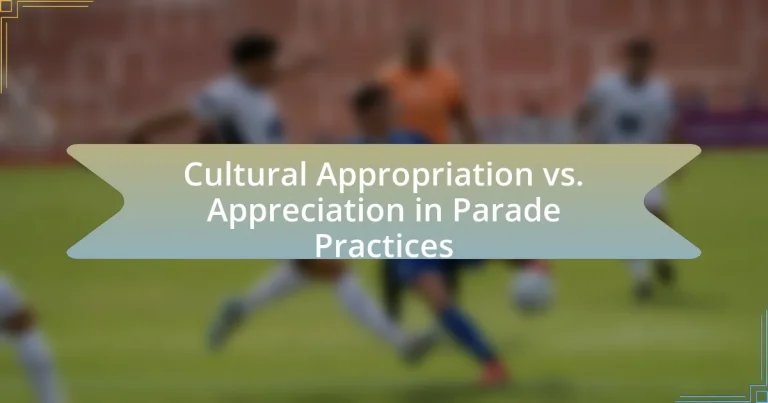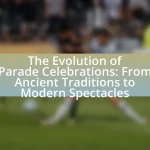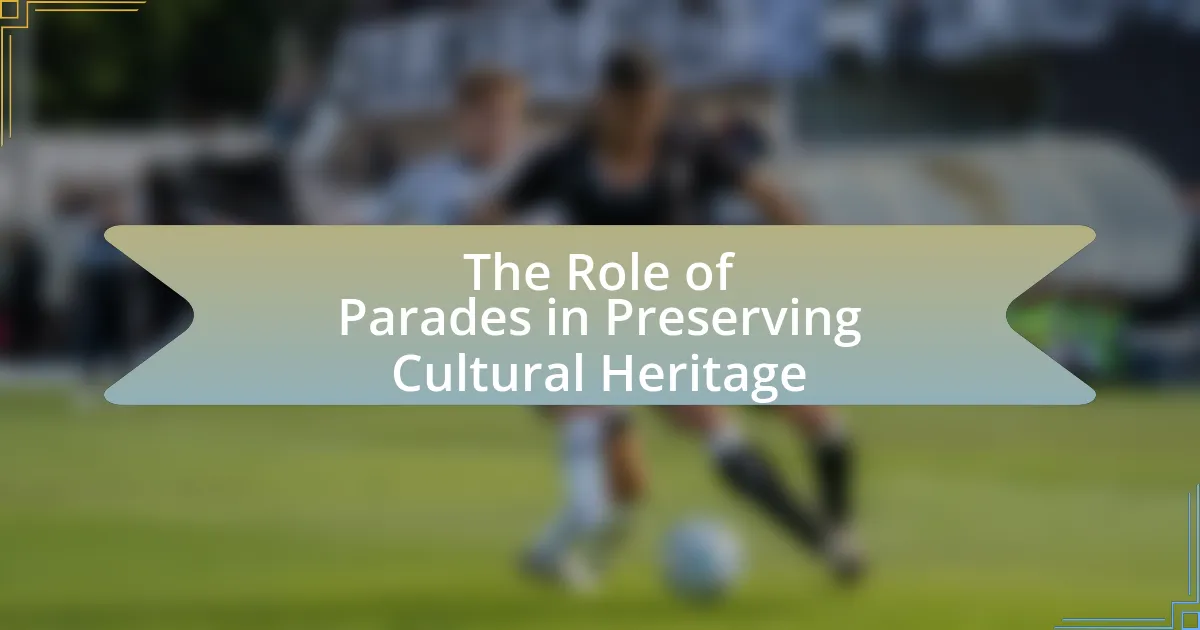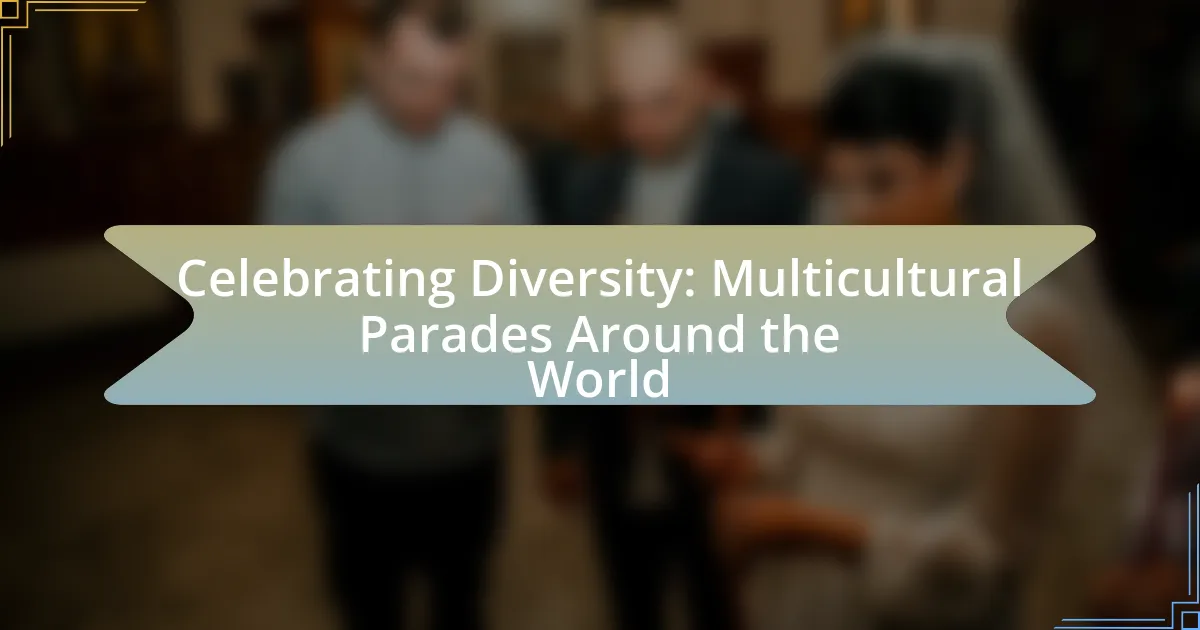Cultural appropriation and appreciation in parade practices are critical concepts that differentiate between the unauthorized use of cultural elements and the respectful acknowledgment of diverse traditions. This article explores the distinctions between appropriation and appreciation, emphasizing the importance of intent, context, and community involvement in cultural representation during parades. It examines the historical contexts of parades, the impact of cultural appropriation on marginalized communities, and the positive outcomes of cultural appreciation. Additionally, the article outlines best practices for ensuring respectful representation and the role of education in fostering understanding among participants and audiences.
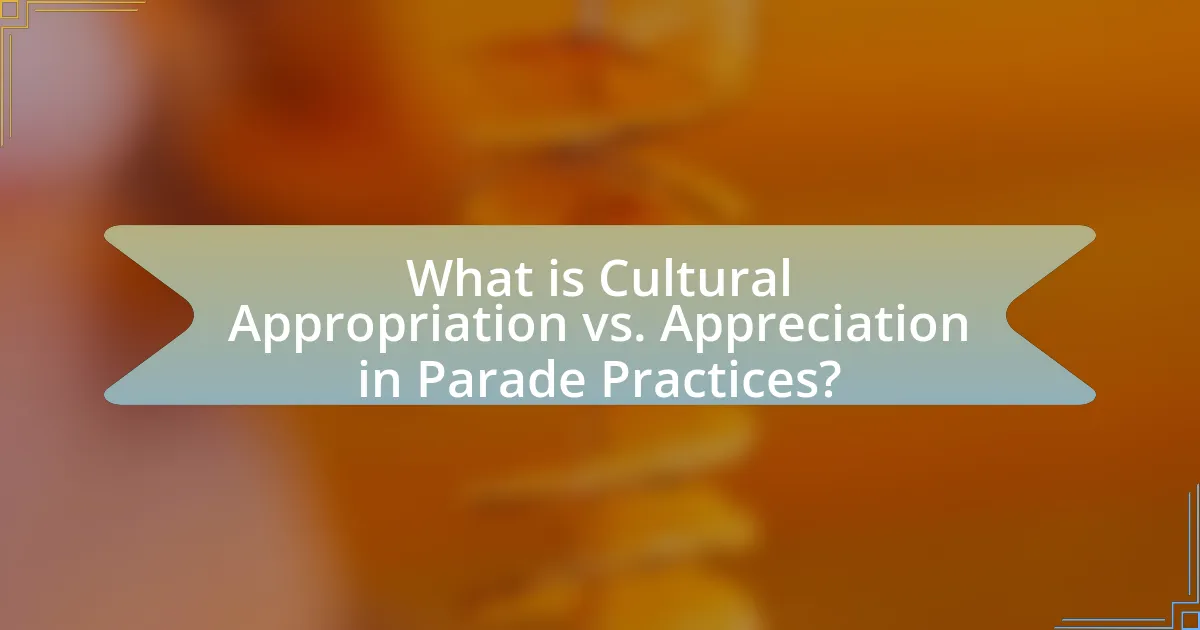
What is Cultural Appropriation vs. Appreciation in Parade Practices?
Cultural appropriation in parade practices refers to the unauthorized use of elements from one culture by individuals or groups from another culture, often leading to misrepresentation or commodification. In contrast, cultural appreciation involves a respectful acknowledgment and celebration of another culture’s traditions, often characterized by understanding and consent from the originating culture. For example, when a parade features traditional attire or symbols from a specific culture without permission or context, it exemplifies appropriation; however, if the parade includes those elements with collaboration and respect for their significance, it reflects appreciation. This distinction is crucial as it impacts community relations and cultural integrity, highlighting the importance of context and intent in cultural exchanges.
How do cultural appropriation and appreciation differ in the context of parades?
Cultural appropriation and appreciation in the context of parades differ primarily in intent and impact. Cultural appropriation occurs when elements of one culture are used by members of another culture, often without permission or understanding, leading to misrepresentation and exploitation, as seen in parades that commodify traditional attire or rituals for entertainment. In contrast, cultural appreciation involves respectful acknowledgment and celebration of another culture, often characterized by collaboration with community members, as demonstrated in parades that highlight cultural heritage through authentic representation and participation of the culture being showcased. This distinction is crucial, as appropriation can perpetuate stereotypes and harm marginalized communities, while appreciation fosters mutual respect and understanding.
What are the key characteristics of cultural appropriation in parade practices?
Cultural appropriation in parade practices is characterized by the unauthorized use of elements from one culture by individuals or groups from another culture, often leading to misrepresentation and commodification. This occurs when dominant cultures adopt symbols, attire, or rituals from marginalized cultures without understanding their significance, resulting in a lack of respect and context. For example, the use of traditional Indigenous headdresses in parades by non-Indigenous participants exemplifies this appropriation, as these items hold deep cultural meaning and are not meant for casual or commercial use. Additionally, cultural appropriation often perpetuates stereotypes and reinforces power imbalances, as the originating culture may not benefit from the representation while the appropriating culture gains visibility and profit.
What defines cultural appreciation in the context of parades?
Cultural appreciation in the context of parades is defined by the respectful recognition and celebration of diverse cultural traditions, practices, and identities. This appreciation manifests through the inclusion of authentic cultural elements, such as traditional costumes, music, and dance, while ensuring that the representation is accurate and honors the origins of those cultures. For instance, parades that feature Indigenous peoples’ traditions must involve their communities in the planning and execution to avoid misrepresentation. This approach fosters understanding and respect, contrasting with cultural appropriation, which often involves taking elements from a culture without permission or understanding, leading to commodification and disrespect.
Why is the distinction between appropriation and appreciation important in parade practices?
The distinction between appropriation and appreciation is crucial in parade practices because it influences how cultural elements are represented and respected. Appropriation often involves taking cultural symbols or practices without understanding their significance, which can lead to misrepresentation and disrespect towards the originating culture. In contrast, appreciation involves a respectful acknowledgment and celebration of cultural elements, fostering understanding and collaboration. For example, parades that incorporate cultural practices through collaboration with community members from those cultures demonstrate appreciation, while those that exploit cultural symbols for commercial gain exemplify appropriation. This distinction is vital to ensure that parades promote inclusivity and respect rather than perpetuating stereotypes or cultural insensitivity.
How can misunderstanding this distinction lead to cultural insensitivity?
Misunderstanding the distinction between cultural appropriation and cultural appreciation can lead to cultural insensitivity by fostering actions that disrespect or exploit marginalized cultures. When individuals fail to recognize the difference, they may adopt elements of a culture without understanding their significance, which can trivialize important cultural symbols and practices. For instance, wearing traditional attire as a costume during parades can perpetuate stereotypes and diminish the cultural heritage of the group being represented. This insensitivity is evidenced by numerous instances where communities have expressed hurt and outrage over the commodification of their cultural practices, highlighting the need for awareness and respect in cultural exchanges.
What impact does this distinction have on community relations during parades?
The distinction between cultural appropriation and appreciation significantly impacts community relations during parades by influencing perceptions of respect and inclusivity. When parade participants engage in cultural appreciation, they foster positive relationships by honoring and celebrating the traditions of different communities, which can lead to increased collaboration and mutual respect. Conversely, cultural appropriation can create tensions and feelings of disrespect among community members, as it often involves the unacknowledged or inappropriate use of cultural symbols, leading to alienation and conflict. For instance, parades that incorporate elements of a culture without proper context or acknowledgment can provoke backlash, as seen in various instances where communities have protested against perceived exploitation of their cultural heritage. Thus, the way cultural elements are utilized in parades directly affects community dynamics and the overall atmosphere of the event.

What are the historical contexts of cultural practices in parades?
Cultural practices in parades have historical contexts rooted in celebration, religious observance, and social commentary. Historically, parades originated in ancient civilizations, such as the Roman triumphs, which celebrated military victories and showcased power. These events often included elaborate displays, music, and performances, reflecting the cultural values and societal structures of the time. In the Middle Ages, parades evolved to include religious processions, which served to reinforce community identity and faith.
In the 19th and 20th centuries, parades became platforms for social movements, such as labor rights and civil rights, where participants used the visibility of parades to advocate for change and express cultural pride. For instance, the Stonewall Riots in 1969 led to the establishment of Pride parades, celebrating LGBTQ+ identities and rights. These historical contexts illustrate how parades have functioned as a means of cultural expression, community solidarity, and political activism, adapting to the social dynamics of their respective eras.
How have parades historically represented cultural identities?
Parades have historically represented cultural identities by serving as public displays of community values, traditions, and social cohesion. For instance, events like the Mardi Gras in New Orleans showcase the unique blend of French, African, and Spanish influences, reflecting the city’s diverse heritage. Similarly, Pride parades celebrate LGBTQ+ identities and rights, originating from the Stonewall riots in 1969, which marked a pivotal moment in the fight for equality. These parades not only highlight cultural expressions but also foster a sense of belonging and visibility within society, reinforcing the importance of cultural identity in public life.
What role did parades play in the expression of marginalized cultures?
Parades serve as a vital platform for the expression of marginalized cultures by providing visibility and a space for cultural celebration. They allow these communities to showcase their traditions, values, and identities, often countering mainstream narratives that may overlook or misrepresent them. For instance, events like Pride parades have historically empowered LGBTQ+ individuals to publicly affirm their identities and advocate for rights, transforming societal perceptions. Additionally, cultural parades, such as those celebrating Indigenous heritage, highlight unique customs and histories, fostering greater awareness and appreciation among broader audiences. This visibility can lead to increased recognition and respect for marginalized cultures, challenging stereotypes and promoting inclusivity.
How have historical events shaped current parade practices?
Historical events have significantly shaped current parade practices by influencing their themes, structures, and cultural representations. For instance, the civil rights movement in the 1960s led to parades that celebrated diversity and social justice, such as Pride parades, which emerged as a response to the LGBTQ+ rights struggle. Additionally, events like the American Revolution inspired patriotic parades that emphasize national identity and unity, reflecting historical contexts in their celebrations. These practices are further informed by historical events such as wars, festivals, and cultural exchanges, which have contributed to the evolution of parades as platforms for both cultural appreciation and, at times, appropriation, highlighting the ongoing dialogue about representation and respect in contemporary celebrations.
What examples illustrate cultural appropriation and appreciation in parades?
Cultural appropriation in parades is exemplified by events like the Mardi Gras in New Orleans, where elements of Indigenous and African cultures are often adopted without proper acknowledgment or respect. In contrast, cultural appreciation is illustrated by the Toronto Caribbean Carnival, which celebrates Caribbean heritage through authentic representation and participation of Caribbean communities, fostering respect and understanding. These examples highlight the distinction between appropriation, which often commodifies culture, and appreciation, which honors and respects cultural origins.
What are notable instances of cultural appropriation in recent parades?
Notable instances of cultural appropriation in recent parades include the 2020 Mardi Gras in Sydney, where participants wore Indigenous-inspired costumes without proper acknowledgment or permission from Indigenous communities. This event sparked significant backlash, highlighting the ongoing issue of cultural insensitivity. Another example is the 2021 Halloween parade in New York City, where several floats featured stereotypical representations of various cultures, leading to protests from affected communities. These instances illustrate the fine line between cultural appreciation and appropriation, emphasizing the need for respectful representation in public celebrations.
How have parades successfully showcased cultural appreciation?
Parades have successfully showcased cultural appreciation by celebrating diverse traditions through vibrant displays of music, dance, and attire. These events often feature participants representing various cultural backgrounds, allowing for the sharing of unique customs and histories with a broader audience. For instance, the annual Mardi Gras in New Orleans highlights African, French, and Spanish influences, fostering an understanding of the city’s multicultural heritage. Additionally, research indicates that parades can enhance community cohesion and promote respect for different cultures, as seen in events like the Pride Parade, which advocates for LGBTQ+ rights while honoring the history and struggles of the community.
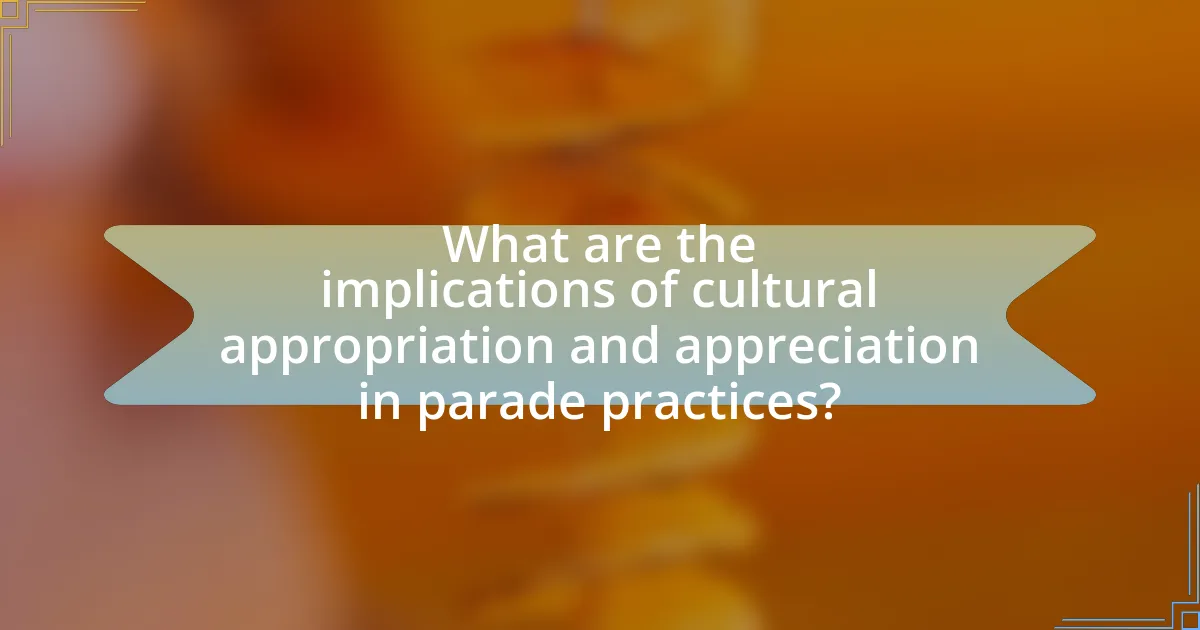
What are the implications of cultural appropriation and appreciation in parade practices?
Cultural appropriation in parade practices often leads to the commodification and misrepresentation of marginalized cultures, resulting in feelings of disrespect and alienation among those communities. For instance, when elements of a culture are used without understanding their significance, it can perpetuate stereotypes and reinforce power imbalances. Conversely, cultural appreciation can foster understanding and respect when done thoughtfully, allowing for the celebration of diversity and shared cultural experiences. However, appreciation must involve genuine engagement and acknowledgment of the cultural origins, as seen in parades that highlight the contributions of various communities while ensuring their voices are included in the narrative.
How does cultural appropriation affect the communities involved?
Cultural appropriation negatively affects the communities involved by undermining their cultural identity and perpetuating stereotypes. When elements of a marginalized culture are adopted without understanding or respect, it can lead to the commodification of cultural symbols, stripping them of their original meaning. For instance, the use of traditional attire in parades by individuals outside the culture often results in misrepresentation and trivialization of significant cultural practices. This dynamic can exacerbate feelings of alienation and resentment within the appropriated community, as their heritage is reduced to a mere aesthetic for entertainment. Studies have shown that such appropriation can lead to economic disadvantages for the original culture, as their cultural expressions are exploited for profit by those outside the community.
What are the potential consequences for communities when appropriation occurs?
Cultural appropriation can lead to significant negative consequences for communities, including the erosion of cultural identity and the commodification of sacred traditions. When dominant cultures adopt elements from marginalized cultures without understanding or respecting their significance, it can result in the misrepresentation and trivialization of those cultures. This often leads to feelings of alienation among community members, as their cultural expressions are stripped of meaning and used for profit or entertainment. For example, the appropriation of Indigenous symbols in fashion can undermine the spiritual and historical importance of those symbols, causing distress within Indigenous communities. Additionally, appropriation can perpetuate stereotypes and reinforce power imbalances, further marginalizing the affected communities.
How can cultural appropriation lead to the commodification of cultural symbols?
Cultural appropriation can lead to the commodification of cultural symbols by transforming these symbols into marketable products, often stripped of their original meaning and significance. When dominant cultures adopt elements from marginalized cultures without permission or understanding, they frequently repackage these elements for commercial gain, such as fashion items, music, or art. This process can result in the dilution of the cultural symbols’ significance, as seen in instances where traditional attire is sold as trendy fashion without acknowledgment of its cultural roots. For example, the use of Native American headdresses in fashion shows exemplifies how sacred symbols can be commodified, reducing their cultural importance to mere aesthetic value.
What positive outcomes can arise from cultural appreciation in parades?
Cultural appreciation in parades can lead to enhanced community cohesion and mutual respect among diverse groups. When individuals participate in parades that celebrate various cultures, they foster an environment of inclusivity and understanding. This is evidenced by events like the New York City Pride Parade, which not only showcases LGBTQ+ culture but also promotes acceptance and solidarity among different communities, resulting in increased social bonds and reduced prejudice. Additionally, cultural appreciation in parades can stimulate local economies through tourism and increased participation, as seen in festivals that attract visitors eager to experience diverse cultural expressions.
How can appreciation foster intercultural dialogue and understanding?
Appreciation can foster intercultural dialogue and understanding by promoting respect and recognition of diverse cultural expressions. When individuals actively appreciate another culture, they engage in meaningful exchanges that highlight similarities and differences, thereby creating a platform for dialogue. Research indicates that appreciation leads to increased empathy and reduces stereotypes, as seen in studies where participants who engaged with diverse cultural practices reported a greater understanding of and respect for those cultures. This mutual respect encourages open communication, allowing for deeper connections and collaborative efforts across cultural boundaries.
What role does education play in promoting cultural appreciation during parades?
Education plays a crucial role in promoting cultural appreciation during parades by providing individuals with knowledge about the diverse cultural backgrounds represented. This understanding fosters respect and recognition of the significance of various cultural expressions showcased in parades. For instance, educational programs that include workshops or community discussions can highlight the historical and social contexts of the cultures being celebrated, thereby reducing the risk of cultural appropriation. Research indicates that when participants are educated about the traditions and meanings behind cultural practices, they are more likely to engage in respectful participation, as seen in events like the New York City Pride Parade, where educational initiatives have been implemented to enhance cultural sensitivity among attendees.
What best practices can be adopted to ensure respectful cultural representation in parades?
To ensure respectful cultural representation in parades, organizers should prioritize collaboration with cultural communities. Engaging representatives from the cultures being represented allows for authentic input and guidance, ensuring that portrayals are accurate and respectful. Research indicates that when cultural groups are involved in the planning process, the likelihood of misrepresentation decreases significantly, fostering a more inclusive environment. Additionally, educating participants about the cultural significance of the elements they are portraying can prevent appropriation and promote appreciation. This approach not only honors the traditions being showcased but also enriches the experience for all attendees.
How can parade organizers engage with cultural communities effectively?
Parade organizers can engage with cultural communities effectively by fostering authentic partnerships and ensuring representation in planning processes. This involves actively involving community leaders and members in decision-making, which enhances cultural sensitivity and relevance. Research indicates that inclusive practices lead to more successful events; for instance, a study by the National Endowment for the Arts found that community involvement in arts programming increases participation and satisfaction rates. By prioritizing collaboration and open communication, parade organizers can create events that honor and celebrate cultural diversity, thereby reducing the risk of cultural appropriation.
What guidelines should be followed to differentiate between appropriation and appreciation in parade practices?
To differentiate between appropriation and appreciation in parade practices, one should prioritize understanding the cultural significance of the elements being used. Appreciation involves respectful engagement with a culture, acknowledging its origins, and involving members of that culture in the representation. In contrast, appropriation occurs when cultural elements are used without permission or understanding, often reducing them to stereotypes or commodified forms.
For instance, a parade that features traditional attire from a specific culture should include individuals from that culture who can provide context and meaning, ensuring that the representation is authentic and respectful. Additionally, it is crucial to avoid using sacred symbols or practices in a trivial manner, as this can lead to misrepresentation and disrespect.
Research indicates that cultural appreciation fosters mutual respect and understanding, while appropriation can perpetuate harmful stereotypes and power imbalances (Cultural Appropriation and the Arts, 2018, by Susan Scafidi). Thus, engaging with cultural representatives and prioritizing education about the cultural elements being showcased are essential guidelines for ensuring appreciation rather than appropriation in parade practices.
